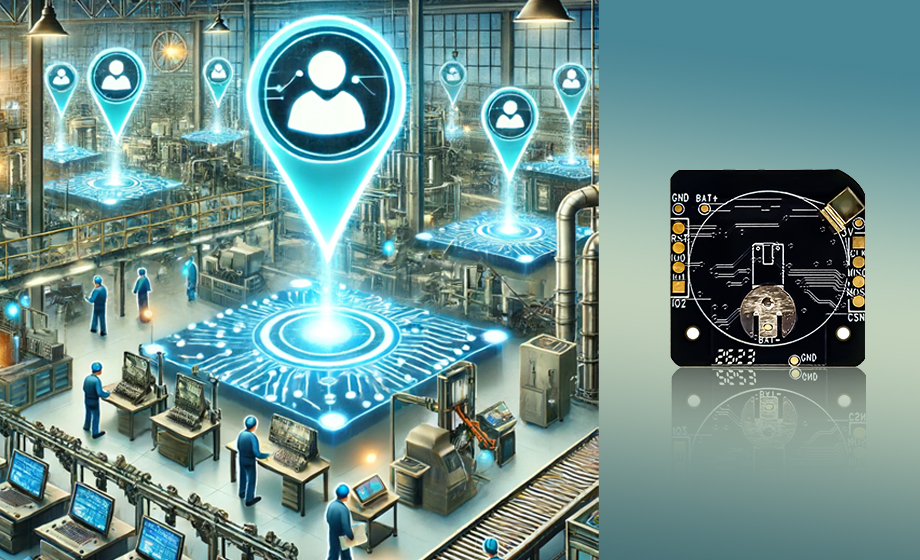I. Introduction
With the rapid development of science and technology, positioning technology has penetrated into all aspects of our lives. Whether it is navigation, logistics or social applications, location has become an indispensable element. In this context, ultra-wideband positioning technology is gradually emerging with its unique advantages. It is worth mentioning that the UWB chip in ultra-wideband technology has pushed this technology to a new height and become an innovative sheep in the field of indoor positioning.

Ii. Overview of UWB positioning technology
Ultra-wideband (UWB) technology is a wireless communication technology that transmits data by sending nanosecond pulses. This technology is unique in that it does not use traditional sine wave signals, but uses extremely short pulse signals, making it high-speed, low-power characteristics. UWB positioning technology uses the propagation characteristics of this signal, combined with time difference, Angle, intensity and other parameters to achieve accurate positioning of the target object. Compared with traditional indoor positioning technologies such as WiFi and Bluetooth, UWB technology performs better in terms of accuracy, stability and power consumption.
Third, UWB chip: technical core and application
UWB chip is the core component of UWB positioning technology. The chip integrates high-precision clock, signal processing and communication modules to achieve centimeter-level or even millimeter-level positioning accuracy. This is due to the advanced technology and complex algorithms of the UWB chip. The application scenarios of UWB chips are very wide, including but not limited to smart home, unmanned driving, robotics, security monitoring and other fields. By combining with iot devices, UWB chips can provide real-time, accurate location information to enhance the intelligence level of various applications. For example, in smart homes, UWB chips can be used to achieve real-time positioning of family members and provide more intelligent services; In unmanned driving, UWB chips can be used for accurate navigation and obstacle avoidance of vehicles; In the field of robotics, UWB chips can be used for autonomous navigation and task execution of robots; In security monitoring, the UWB chip can be used to achieve accurate target tracking and alarm.
4. Advantages and challenges of UWB ultra-wideband wireless technology
UWB ultra-wideband wireless technology has the advantages of high precision, low delay and anti-interference. Its accuracy can reach the centimeter level or even the millimeter level, providing powerful position information support for various applications. The low latency characteristics make the data transmission speed fast and the response is rapid, which meets the demand of real-time. In addition, UWB technology has strong anti-interference ability and can work stably in complex environments. However, in practical application, there are still some challenges. The first is the problem of equipment cost, because the UWB chip needs to integrate more components, the manufacturing cost is relatively high. The second is the signal interference problem, although UWB has a strong anti-interference ability, but in some environments may still be interfered by other signals. Due to the propagation characteristics of UWB signal, its coverage is limited, and it is necessary to rationally arrange the base station or access point.
5. Industry application and market prospect
With the development of the Internet of Things and intelligence, the application prospect of UWB technology is very broad. In the field of smart home, as people's demand for smart life increases, UWB chips can be used for precise control and location services of smart speakers, smart bulbs and other devices. In the field of smart cities, UWB technology can be used in intelligent transportation, intelligent security and other systems to achieve accurate vehicle navigation and obstacle avoidance, pedestrian flow statistics and other functions. In the field of logistics, UWB technology can achieve accurate tracking and management of goods, improving logistics efficiency and accuracy. In the field of iot, various devices need real-time location information to provide better services. UWB technology can meet this demand and provide strong support for the development and application of the Internet of Things. In the future, with the popularization and application of 5G technology, UWB technology will have greater development space and application potential in the field of indoor positioning. For example, the high speed and low latency characteristics of 5G networks can be combined with the advantages of UWB technology to provide faster and more stable services for a variety of applications. At the same time, with the continuous progress of technology and the continuous expansion of application scenarios, the cost of UWB technology will gradually reduce, so that more devices can use this advanced technology.
Vi. Conclusion
Ultra-wideband positioning technology and UWB chip are leading the future development of indoor positioning field with their unique advantages and potential. With the continuous progress of technology and the continuous expansion of application scenarios, UWB technology will play an important role in more fields. We believe that in the near future, UWB technology will become the standard in the field of indoor positioning, bringing more convenience and possibilities to our life and work. Therefore, it is of great significance to research and develop UWB positioning technology and UWB chip. In the future development, technology research and development efforts should be further increased to reduce costs and improve stability and coverage. After solving problems such as ultra-wideband positioning technology and UWB chips, there will be broader application prospects and market space.



